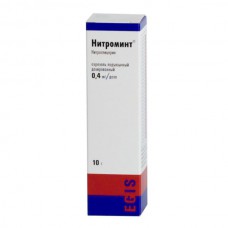Expiration date: 08/2026
The composition and form of issue:
Aerosol hypoglossal dosed 1 cylinder
active substance:
nitroglycerin 0.08 g
(1% (m/m) solution)
excipients: ethanol (96%) — 7,92 g propylene glycol 2 g
in aerosol containers made of aluminum with metering device containing 10 g of solution (180 doses at 0.4 mg/dose) in the paper cartons 1 a bottle.
Description pharmaceutical form:
Colourless or almost colourless clear solution without precipitate.
Pharmacokinetics:
Nitromint aerosol quickly and completely absorbed from the oral cavity into the systemic circulation.
The bioavailability of the drug Nitromint is 100% with sublingual intake, as excluded primary hepatic degradation of the drug. Cmax in plasma achieved within 4 min. the Relationship with blood plasma proteins is 60 %. Rapidly metabolized with the participation nitratereductase, with the formation of di - and mononitrates (only active isosorbide-5-Mononitrate), the ultimate metabolite is glycerol. Excreted by the kidneys as metabolites. Total clearance is 25-30 l/min After administration of the drug under the tongue T1/2 from blood plasma is 2.5 to 4.4 min. Circulating nitroglycerin strongly associated with erythrocytes and accumulates in the vessel walls. The main route of excretion of nitroglycerin — urinary excretion of metabolites in urine less than 1% of the administered dose excreted unchanged.
Description pharmacological action:
Nitroglycerin is an organic nitrogen-containing compound with a primary venodilation action.
Effects of nitroglycerin due to its ability to release its molecule of nitric oxide, a natural endothelial relaxing factor. Nitric oxide increases intracellular concentration of cGMP, which prevents the penetration of calcium ions into smooth muscle cells and causes their relaxation. The relaxation of smooth muscles of the vascular wall and causes vasodilation, which reduces venous return to heart (preload) and the resistance of the systemic circulation (afterload). This reduces the work of heart and the need of myocardium in oxygen. Expansion of coronary vessels and improves coronary blood flow and contributes to its redistribution in the region with reduced blood circulation, which increases oxygen delivery to the myocardium. The decrease in venous return leads to a decrease in filling pressure, improve blood supply of the upper subendocardialnah layers, reducing the pressure in the pulmonary circulation and regression of symptoms oteke light. Nitroglycerin exerts a Central inhibitory effect on sympathetic vascular tone, inhibiting the vascular component of pain syndrome. Nitroglycerin also relaxes the smooth muscle cells of the bronchi, urinary tract, gallbladder, bile ducts, esophagus, small intestine and colon, as well as their sphincters. Nitromint the action starts quickly, the effect is within 1-1,5 min and lasts approximately 30 min.
Indications:
- angina (mild and preventing attacks, including before exercise)
- acute left ventricular failure (adjuvant therapy).
Contraindications:
- hypersensitivity to organic nitrates
- shock
- collapse
- age to 18 years of age (no sufficient clinical data).
With care: acute circulatory failure, accompanied by severe hypotension (garden below 90 mm Hg.St.), orthostatic hypotension, hemorrhagic stroke, acute myocardial infarction and chronic heart insufficiency with low filling pressure of the left ventricle, hypertrophic cardiomyopathy, severe renal and/or hepatic failure, severe anemia and hyperthyroidism, alcoholism, epilepsy, head trauma, intracranial hypertension, angle-closure glaucoma (risk of increased intraocular pressure), migraine.
Application of pregnancy and breast-feeding:
Excretion of nitroglycerin in human breast milk is not established.
The use of the drug Nitromist during pregnancy and during breast-feeding requires careful mapping of risks and benefits and should be under strict medical supervision.
Side effects:
From the CCC: dizziness, headache, tachycardia, fever, decrease in blood pressure rare (especially in overdose) — orthostatic collapse, cyanosis.
From the digestive system: dry mouth, rarely — nausea, vomiting, abdominal pain.
CNS: weakness rare anxiety, psychotic reactions, confusion, disorientation.
Allergic reactions: rarely — skin rash, itching.
Local reactions: hyperemia skin, burning under the tongue.
Other: rarely — blurred vision, hypothermia, methemoglobinemia.
Drug interactions:
Other vasodilators and antihypertensive drugs (beta-blockers, blockers slow calcium channels), ACE inhibitors, antipsychotics, tricyclic antidepressants, MAO inhibitors, phosphodiesterase ingibitory, procainamide and ethanol may enhance the hypotensive effect of the drug Nitromint.
Method of application and dose:
Sublingual. Before first use, container should be filled metering pump by removing the protective cap and pressing on the metering valve until you see spray. After a long break in use of the bottle may need re-filling of the pump. When you use the container should be held upright, the spray head up. Each press on the metering valve releases the 1 dose (0.4 mg of nitroglycerin) in aerosol form from a container equipped with a mechanical pump. Shake the container before use is not necessary.
For the relief of angina: 0.4–0.8 mg (1-2 doses) by clicking on the metering valve, preferably in a position "sitting", when holding the breath at intervals of 30 then you should close your mouth for a few seconds. If necessary re-introduction, but not more than 1.2 mg (3 doses) for 15 min.
To prevent the development of seizure — 0.4 mg (1 dose) for 5-10 min before loading.
In acute left ventricular failure, pulmonary edema developing: 1.6 mg (4 doses) and more in a short period of time and under strict control of the circulation (SBP must be >100 mm Hg. calendar). With insufficient therapeutic effect of the same dose can be repeated after 10 min.
Does not require changes in dosing regimen in applying the drug in elderly patients.
Overdose:
Symptoms: headache, reducing AD, ortostatical gipotenzia, reflex tachycardia, dizziness, facial flushing, vomiting and diarrhoea, asthenia, hypersomnia, a feeling of heat. Extremely high doses (over 20 mg/kg) cause of methemohlobinemia, cyanosis, dyspnoea and tachypnea, orthostatic collapse.
Treatment: in mild cases — the transfer of the patient in the supine position with raised legs. In severe symptoms of overdose should apply the General methods of treatment of intoxication and shock (to fill the BCC, norepinephrine and/or dopamine, etc.). The use of epinephrine is contraindicated.
With the development of methemohlobinemia you can apply the following antidote and treatment:
1. Vitamin C at a dose of 1 g in the form of sodium salt in or.
2. Methylene blue in/in the dose to 50 ml of a 1% solution.
3. Toluidine blue/first dose of 2-4 mg/kg, then multiply by 2 mg/kg.
4. Oxygen therapy, hemodialysis, transfusion (exchange) blood.
Special instructions:
Nitromint increases the excretion of catecholamines and vanillylmandelic acid in the urine. The use of alcoholic beverages during the use of the drug is strictly prohibited.
The impact on driving and work requiring attention
At the beginning of treatment should refrain from driving vehicles and activities potentially hazardous activities, require high concentration and psychomotor speed reactions. In the future, the degree of restriction is determined individually for each patient.
Storage conditions:
The preparation is flammable and explosive! Empty cylinder do not throw in the fire! Do not store and use near open flame or while Smoking!


